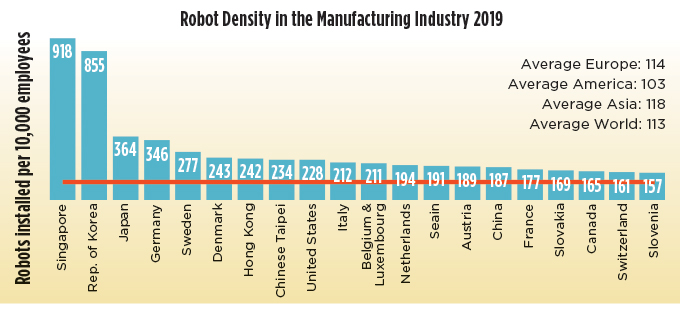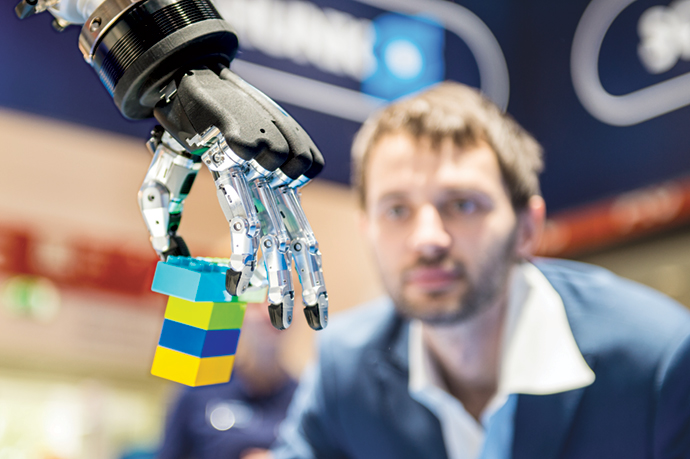Automation is always ready. Which parts of the world are most ready for it?
Answers to that question and related questions can always be found in Frankfurt, Germany, home of the International Federal of Robotics (IFR). A survey of recent IFR data and business intelligence offers a clear picture of where advanced manufacturing is headed, and how best to get there, as almost 4 million industrial robots are expected to be working in factories worldwide by 2022.
Released in September, the World Robotics 2020 Industrial Robots report showed a record of 2.7 million industrial robots operating in factories around the world — an increase of 12%. A total of 373,000 units were shipped globally in 2019, down by 12% vs. 2018, but still the third highest sales volume ever recorded. From 2014 through 2019, installed robots have increased by 85%.
“The stock of industrial robots operating in factories around the world today marks the highest level in history,” said Milton Guerry, president of the International Federation of Robotics, attributing the 2019 hiccup to “difficult times the two main customer industries, automotive and electrical/electronics, have experienced.”
Those difficult times spread to everyone as the global pandemic struck. Guerry thought a stimulus to the industry from large-scale orders was unlikely for the balance of 2020. “2021 will see recovery, but it may take until 2022 or 2023 to reach the pre-crisis level,” he said.
A geographic rundown from the report:
Asia remains the strongest market for industrial robots, with operational stock for the region´s largest adopter China rising by 21% to 783,000 units in 2019. Japan ranks second with about 355,000 units, a jump of 12%. Within five years, India has doubled the number of industrial robots operating in the country´s factories to about 26,300.

The share of newly installed robots in Asia was about two-thirds of global supply, the IFR reported.
Europe reached an operational stock of 580,000 units in 2019 — up by 7%. Germany remains the main user with an operational stock of about 221,500 units — about three times the stock of Italy (74,400 units), five times the stock of France (42,000 units) and 10 times the stock of the UK (21,700 units). By percentage, France led major European countries in robot sales, rising by 15% in 2019. Meanwhile, the UK continues to lag, with new installations slowing by 16%. “The newly installed 2,000 units in the UK are about 10 times less than the shipments in Germany (20,500 units), about five times less than in Italy (11,100 units) and about three times less than in France (6,700 units),” the IFR reported.
In the Americas, industrial robots in the U.S. reached a new operational stock record of about 293,200 units, up 7%. Mexico comes second with 40,300 units, up 11%, followed by Canada with about 28,600 units, up 2%. Most of the robots in the U.S. are imported from Japan and Europe. “Although there are not many North American robot manufacturers,” the report notes, “there are numerous important robot system integrators.”
South America´s No. 1 operational stock is in Brazil with almost 15,300 units, up by 8%. Sales slowed down by 17% with about 1,800 installations — still one of the best results ever, only beaten by record shipments in 2018.
“The adoption of human-robot collaboration is on the rise,” the IFR reported. “We saw cobot installations grew by 11% … As more and more suppliers offer collaborative robots and the range of applications becomes bigger, the market share reached 4.8% of the total of 373,000 industrial robots installed in 2019. Although this market is growing rapidly, it is still in its infancy.”
R&D and Skills Essential
According to the “automation readiness index” published by The Economist Intelligence Unit, South Korea, Estonia, Singapore and Germany are the only countries ready for an automated economy, with Japan, the U.S. and France developed and China emerging. The IFR in 2020 added dimension to these findings by surveying robotics R&D programs around the world.
The Made in China 2025 strategic plan includes advanced robots among the top 10 core industries. “The Robot Industry Development Plan sets out the goals for China in 2020,” the IFR reports, “including: (1) developing three to five globally competitive robot manufacturers, (2) creating eight to 10 industrial clusters, (3) achieving 45% of domestic market share for China’s high-end robots, and (4) increasing China’s robot density to 100 robots per 10,000 workers.
In Japan, the robot-related budget for 2019 was increased to $351 million, with the aim to make Japan the robot innovation hub of the world. The action plan includes manufacturing as well as important service sectors like healthcare, agriculture and infrastructure. Japan is the world´s No. 1 industrial robot manufacturer and delivered 52% of the global supply in 2018.
“The Intelligent Robot Development and Supply Promotion Act of Korea is pushing to develop the robot industry in Korea as a core industry in the fourth industrial revolution,” says the IFR. Focus areas are: manufacturing businesses, selected service robot areas (including healthcare and logistics), next-generation key components and key robot software.
Robotics projects funded by the EU’s Horizon 2020 framework program range from manufacturing, commercial and healthcare use to consumer, transportation, and agri-food robotics. The European Commission will provide around $780 million for robotics research and innovation over the program’s seven-year runtime. “The main topics of the Work Program 2018-2020 are related to digitization of industry through robotics, robotics applications in promising new areas, and robotics core technologies such as AI and cognition, cognitive mechatronics, socially cooperative human-robot interaction, and model-based design and configuration tools,” says the IFR, with the total budget of $173 million. With $55 million budgeted over five years, Germany’s “PAiCE” program emphasizes the development of digital industry platforms.
The National Robotics Initiative (NRI) in the U.S. focuses on fundamental science, technologies, and integrated systems needed to achieve a vision of ubiquitous collaborative robots assisting humans in every aspect of life, and had a budget of $35 million in 2019. Additional robotics funding for applications in defense and space is provided through the Department of Defense and the Mars Exploration Program.
The IFR highlighted in August the role that robots will play in revving the post-COVID-19 economy. But they need skilled workers to work with them.
“Demand for technical and digital skills is increasing, but equally important are cognitive skills like problem-solving and critical thinking,” said Dr. Susanne Bieller, IFR´s general secretary. “Economies must embrace automation and build the skills required to profit — otherwise they will be at a competitive disadvantage.”

